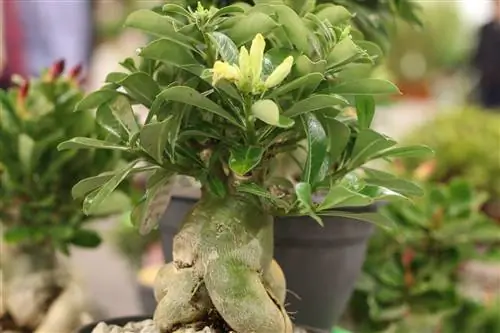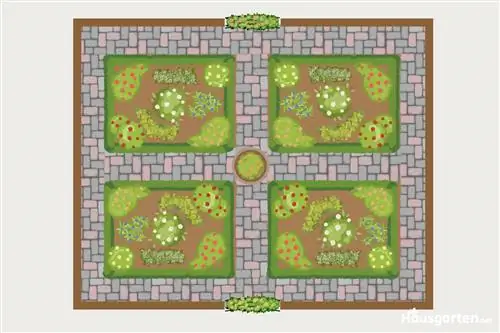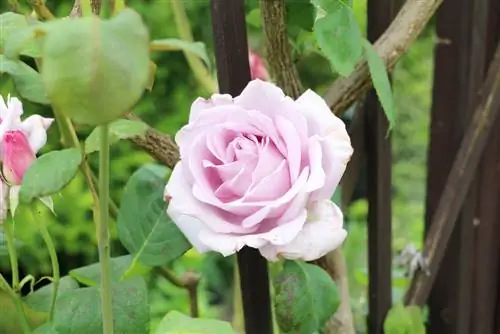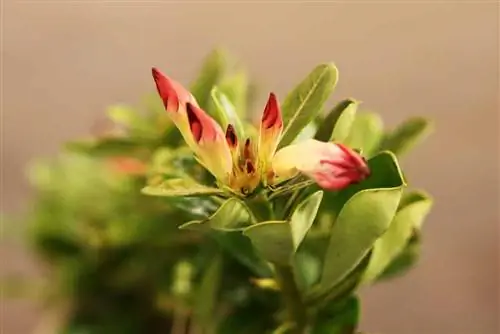- Author admin [email protected].
- Public 2023-12-17 03:39.
- Last modified 2025-06-01 06:48.
Just one look at the bizarre stem of the plant reveals where the desert rose originally comes from. Hardy by the hot, dry climate of the steppes of Africa and Asia, Adenium obesum is able to survive for long periods without water if necessary. Nevertheless, the dogpoison plant is anything but boring, as it impresses with its dark green foliage and fascinating floral flora. The desert rose is still relatively unknown in our latitudes, but it is an extremely robust and easy-care houseplant.
Location and substrate
In their natural habitat, desert roses are impressive plants that can reach a height of up to 4 meters. You shouldn't be fooled by its immense size and heavily thickened trunk, because botanically Adenium obesum is classified as a shrub family. The African plant is able to survive even long periods of drought without causing visual deficiency symptoms. The desert rose requires warmth and a location in full sun. Since the exotic plants in our latitudes are almost exclusively cultivated as houseplants, you should choose a place in the winter garden or on a south-facing window. In the warm summer months, you can also give the plant a sheltered location on the balcony or sunny terrace. However, as soon as the temperatures drop below 15°C, the plant has to vacate its outdoor space again.
The plant needs a permeable and low-lime substrate. If you use conventional potting soil, you should enrich it with humus and at least 50% sand. Slightly more expensive, but ideally suited to the needs of succulents, is a special cactus soil from specialist retailers.
Watering and fertilizing
Adenium obesum is a type of plant that needs to be watered properly. This is the only way you can enjoy the lush flowers. The plant is designed to survive almost without water for several months. The thick trunk stores valuable water during the barren rainy season. However, the desert rose does not last quite as long in plant containers. Nevertheless, it is able to survive several hot summer days without water if necessary. During the flowering period in summer you should keep the substrate moderately moist. If you only allow the top layer of soil to dry out, it will be beneficial for the flowers to bloom. Like all succulents, the desert rose is extremely sensitive to waterlogging. A permeable substrate and drainage made of porous material at the bottom of the bucket ensure that the plant does not get its feet wet.
From the end of September, the dogpoison family takes a break from vegetation. Until spring, Adenium obesum only receives moderate watering every few weeks. Maintain this “dry rest period” under all circumstances. Only by stopping growth this way can the plant survive the cold season unscathed and produce new flowers the following year. When caring for cacti and succulents, you should use lime-free water. Lime builds up in the roots and makes it difficult for nutrients and water to be absorbed. The plant visibly suffers and could die completely.
Desert plants also have no objection to regular fertilizer application. From March to August, the soil is mixed with a special cactus fertilizer. Conventional fertilizer products for houseplants often have too high a nitrogen content. This damages and weakens the slow-growing desert rose. In the winter months, the supply of water is limited to a minimum and fertilization is stopped completely.
Planting and repotting
Purchased plants should be placed in fresh cactus soil immediately after their first flowering. Otherwise, only repot when the pot is completely penetrated by the roots. This can take 4 to 5 years for the desert flower.
- Choose a sufficiently large planter.
- Create a drainage made of lava grit or expanded clay at the bottom of the vessel.
- Apply a layer of substrate about 3 centimeters thick directly over the porous material.
- Remove the plant roots generously from the old soil.
- Insert the desert rose and fill the cavities with fresh substrate.
- Pour firmly.
No further steps are necessary, regardless of whether you want to plant self-grown cuttings or repot Adenium obesum. During winter dormancy you should disturb the desert rose as rarely as possible. Therefore, only treat the African beauty to a new planter during the main growing season.
Propagate
The still relatively unknown houseplants are propagated via cuttings and seeds. The latter method is extremely time-consuming and requires a lot of patience. It can take several months for the first shoot tips to appear. Cover the seeds minimally with lean, sandy substrate and keep it evenly moist. High humidity and temperatures between 18° - 22°C contribute positively to germination. It is not unusual for the offspring of colorfully blooming Adenium obesum to produce dark pink flowers again. The best time to take cuttings is spring. Cut off shoots about 10 cm long with a sharp knife blade.
- Use a shallow growing container.
- The substrate should be low in nutrients.
- Avoid direct sunlight.
- Water regularly with a water sprayer.
Wrap the entire planter and cutting with lightly perforated, clear film. If the construction doesn't hold, you can attach the foil to a makeshift rack made of kebab skewers. While growing seeds requires some patience from the hobby gardener, propagation from cuttings also has a negative side: many desert roses that were propagated this way lack a distinctive trunk. This “caudex” is responsible for the characteristic appearance of the African plant.
Wintering
Proper accommodation and care in the cold season is important for flowering the following year. The winter quarters should have temperatures between 10° - 15°C. Warmth and a moist substrate promote the growth of the desert rose, which should be avoided at all costs. Maintain dry rest and give the plant a bright location. Proximity to active radiators is tolerated, but can promote infestation with harmful insects such as spider mites.
Tip:
Did you know that succulents can also get “sunburn” in spring? Protect the plants from the midday sun for the first few days.
Diseases and pests
Spider mites and root rot do not stop at even the robust desert roses. The harmful insects are particularly active in winter, when the plants are weakened by the dry indoor air. This can be quickly remedied if you increase the humidity significantly and also spray the plant with a decoction of diluted nettles. You can also carefully remove pests from the desert rose in the bathtub using a jet of water. Root rot, on the other hand, occurs when the plant is unnecessarily exposed to standing moisture for a long time. A permeable substrate, drainage at the bottom of the container and correct watering counteract infestation.
Conclusion of the editors
Adenium obesum is the ideal plant for lovers of exotic plants. The African desert rose is easy to cultivate and can definitely be forgotten when watering. If the location and care conditions match, you can enjoy the lush and fascinating flowers of the succulent in summer.
What you should know about the desert rose in brief
Care
- The desert rose (Adenium obesum) definitely needs a very sunny place because it comes from steppe areas in Africa and Arabia.
- As a houseplant, it should be placed in a south-facing window, but it is even better to put it outside during the summer months.
- But before the outside temperatures drop below 10° C, she has to be brought back into the house because she cannot tolerate the cold.
- When watering, pay attention to whether it is a rootless plant.
- Or a desert rose that was grafted onto an oleander trunk
Root vs. refined varieties
- In true-root plants, the trunk has a tuber-like shape.
- Refined plants, on the other hand, have a rather thin and even trunk.
- Root-real desert roses react very sensitively to too much water and should therefore be watered extremely sparingly.
- They have the ability to store water in their trunk and can therefore survive longer dry periods.
- Refined desert roses may be watered a little more.
- Ordinary potting soil can be used as a substrate for them, while only permeable substrate is an option for the real root ones.
- Because the desert rose grows strongly in the direction of the light, it should be turned from time to time to ensure even growth.
Winter Care
- The desert rose takes a break in the wild in winter. This break should also be observed with a houseplant.
- This makes the desert rose bloom even more beautifully the following year. To do this, it is placed in a room with a temperature of around 15 °C.
- Irrigation should be avoided almost entirely.
- The plant will then lose most of its leaves, leaving only the trunk, but will grow new ones next spring.
- To support it in this, after the winter it is placed on a windowsill that is as bright and warm as possible.
- If overwintering in a cool room is not possible, the desert rose can also be kept in a heated room all year round.
- As a houseplant, the desert rose usually blooms twice a year, namely in spring and autumn.
- Then large flowers are formed that are red or pink on the outside and white on the inside. They last a long time, but have little scent.
- Between these two flowering phases, the desert rose can be repotted if necessary.
- It can also be cut back during this time, but please note that it contains a milky sap that is very poisonous!
Propagation
- Desert roses can be grown from seeds, but they can also be propagated from cuttings.
- To do this, shoots are cut off from an existing desert rose in spring and planted in the ground.
- However, the interfaces should dry for a day or two beforehand.
- After planting the cuttings, the soil is kept only slightly moist and the pot is placed in a bright and warm place.
- Desert roses grown from cuttings, however, have the disadvantage that they do not form the thick stem base typical of this plant.
- If you value not only the flowers, but also the interesting, thick trunk, it is better to grow a desert rose from seeds.






